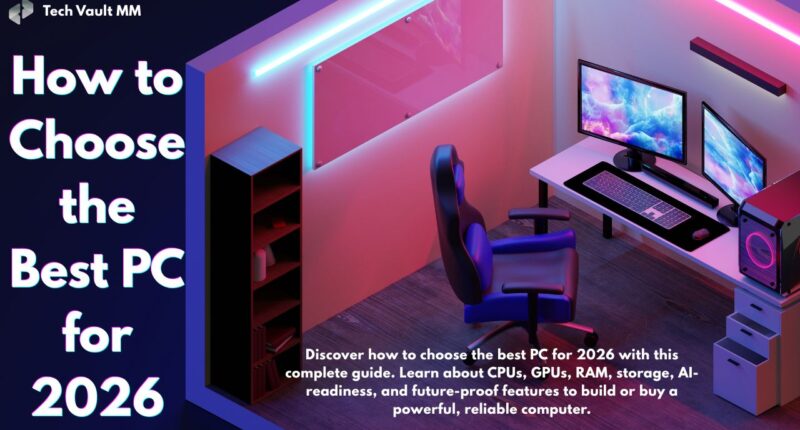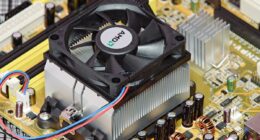How to Choose the Best PC for 2026
Choosing the best PC in 2026 can feel overwhelming—there are countless processors, graphics cards, form‑factors and new language about AI and NPUs. But with the right framework and a clear understanding of your needs, you can pick a machine that will serve you well into the future. In this guide I’ll walk you through what to prioritise so you end up with a PC that is future‑ready, efficient and well‑balanced. https://techvaultmm.com
Define Your Use Case First
Before diving into components or brands, it’s vital to ask: what will I use this PC for? The answer will shape every decision on hardware, budget and upgrade path.
Everyday Use (Browsing, Office, Streaming)
If your tasks include email, web browsing, streaming videos, light photo editing and perhaps some casual gaming, you don’t need top‑tier hardware. Ideally:
-
A mid‑range processor (e.g., Intel Core i5 or AMD Ryzen 5)
-
8‑16 GB of RAM (16 GB is becoming the new baseline)
-
Fast SSD storage (at least 512 GB)
-
A balanced graphics option (integrated GPU often suffices)
This approach keeps cost down and ensures a smooth, responsive system without over‑spending.
Gaming / Content Creation / Workstation
For heavier usage—competitive or AAA gaming, video editing, 3D modelling, streaming—you’ll want a more robust build:
-
High‑performance CPU (Intel Core i7/i9 or AMD Ryzen 7/9)
-
Discrete graphics card capable of 1440p or 4K performance
-
32 GB (or more) RAM for multitasking
-
High‑speed NVMe SSD for fast load times and file handling
-
Good cooling and power supply to support the load
This ensures your PC stays relevant and powerful for years to come.
Key Specifications to Look For in 2026
With your use‑case clear, let’s zero in on the spec‑sheet and understand how each main component matters.
Processor (CPU)
The CPU remains the brain of your machine. For 2026, look for processors that:
-
Support current platforms (so you can upgrade in future)
-
Offer strong single‑thread and multi‑thread performance
-
Align with your workload (e.g., gaming benefits from strong single‑thread; content creation from many cores)
For example, guides suggest mid‑level processors like Intel Core i5/i7 or AMD Ryzen 5/7 for everyday use. Microsoft+2Microsoft+2
If you’ll use your PC for AI‑enhanced tasks or heavy workloads, consider processors with built‑in NPUs or AI acceleration.
Memory (RAM)
RAM is critical for smooth multitasking and future‑proofing:
-
At minimum 16 GB for most users in 2026.
-
For gaming, content creation or heavy multitasking: 32 GB or even 64 GB.
-
Faster RAM helps too (DDR5 is standard now).
One buyer guide states: “Minimum 16 GB DDR5 (DDR4 to hold only for budgets)”.
Storage (SSD)
Storage speed matters greatly. For 2026 you should aim for:
-
NVMe SSD (PCIe 4.0 or better) as the primary drive.
-
Capacity of at least 1 TB if you store many large files (games, videos, etc.).
-
Secondary storage (SATA SSD/HDD) is fine for archive or backups.
Buying guides emphasise the importance of SSDs rather than older spinning drives.
Graphics Card (GPU)
The GPU is key for gaming, creative workloads, and even AI tasks:
-
For 1080p gaming: mid‑range card is sufficient
-
For 1440p/4K: high‑end GPU is required
Prior guides suggest checking VRAM capacity—12 GB+ is becoming a baseline for modern titles.
Also ensure the system is balanced so the GPU isn’t bottlenecked.
Future‑proofing & AI Expectations
In 2026 especially, keep one eye on future trends:
-
NPUs (Neural Processing Units) and AI capability built into PCs are growing.
-
Choose platforms that support upgrades (socket, chipset, memory).
-
Don’t over‑spend on bleeding‑edge features if you’ll never use them; instead optimise value.
Additional Considerations & Practical Tips
Form Factor & Upgradeability
Will you build a desktop or buy a laptop/pre‑built? Consider:
-
Desktop: easier to upgrade, better cooling, better value.
-
Laptop: portability, compactness, but often harder to upgrade.
And always check the upgrade path: is the motherboard socket future‑compatible? Can you add RAM/SSD later?
Cooling & Power Supply
When you invest in higher‑performance hardware, you must support it:
-
A quality power supply (80 Plus certified) that gives headroom.
-
Good airflow or liquid cooling to avoid thermal throttling.
Cooling and PSU are often overlooked but vital for longevity and stability. digitalnew.it.com
Budget & Timing
Set a realistic budget. The smartest buyers target the “sweet spot” where price vs performance is optimal.
-
Don’t chase last‑bit extra performance if you won’t use it.
-
Consider timing: new hardware launches might drop prices of previous generation.
-
Ensure warranty, reliable brand support, and good reviews.
Build vs Buy
Decide whether you’ll build your own PC or buy a pre‑built.
Building can offer better value and control; buying is convenient and often includes support. But regardless of route, apply the same spec wise principles above.
Summary & Final Checklist
Here are the quick checkpoints to follow when selecting your best PC for 2026:
-
✅ Define your use: everyday tasks vs gaming vs creation.
-
✅ Choose a CPU suited to your workload, with upgrade headroom.
-
✅ Get 16 GB+ RAM (32 GB if heavier usage).
-
✅ Use NVMe SSD, preferably 1 TB or more.
-
✅ Match GPU to your display/resolution needs.
-
✅ Ensure system has upgradeability, quality cooling, and power.
-
✅ Set a practical budget and check current market value.
-
✅ Verify reviews, brand reliability and support.
When you buy with purpose and clarity, you’ll choose a PC that works today and still matters tomorrow. With the evolving landscape of AI, NPUs, high‑speed storage and powerful graphics, a thoughtful decision now will hold up through 2026 and beyond. https://techvaultmm.com









